Effects of Long-Term Fenced Enclosure on Soil Physicochemical Properties and Infiltration Ability in Grasslands of Yunwu Mountain, China
Abstract
:1. Introduction
2. Materials and Methods
2.1. Study Sites
2.2. Measurements of Soil Properties
2.3. Measurements of Soil Aggregate Traits
2.4. Measurements of Soil Water Infiltration Rate
2.5. Statistical Analysis
3. Results
3.1. Soil Properties of Grassland with Different Enclosure Years
3.2. Characteristics of Soil Aggregates in Grasslands with Different Enclosure Years
3.3. Soil Water Infiltration Characteristics of Grassland with Different Enclosure Years
3.4. Analysis of Influencing Factors of Soil Water Infiltration Capacity
4. Discussion
5. Conclusions
Author Contributions
Funding
Data Availability Statement
Conflicts of Interest
References
- Zhang, Y.; Xie, Y.; Ma, H.; Jing, L.; Matthew, C.; Li, J. Rebuilding Soil Organic C Stocks in Degraded Grassland by Grazing Exclusion: A Linked Decline in Soil Inorganic C. PeerJ 2020, 8, e8986. [Google Scholar] [CrossRef]
- Dlamini, P.; Chivenge, P.; Chaplot, V. Overgrazing decreases soil organic carbon stocks the most under dry climates and low soil pH: A meta-analysis shows. Agric. Ecosyst. Environ. 2016, 221, 258–269. [Google Scholar] [CrossRef]
- Lai, L.; Kumar, S. A global meta-analysis of livestock grazing impacts on soil properties. PLoS ONE 2020, 15, e0236638. [Google Scholar] [CrossRef]
- Yan, Y.; Lu, X. Is grazing exclusion effective in restoring vegetation in degraded alpine grasslands in Tibet, China? PeerJ 2015, 3, e1020. [Google Scholar] [CrossRef]
- Le, K.; Han, X.; Zhang, Z.; Sun, O.J. Grassland ecosystems in China: Review of current knowledge and research advancement. Philos. Trans. R. Soc. B Biol. Sci. 2007, 362, 997–1008. [Google Scholar]
- Qiao, Y.; Zhu, H.; Zhong, H.; Li, Y. Stratified Data Reconstruction and Spatial Pattern Analyses of Soil Bulk Density in the Northern Grasslands of China. ISPRS Int. J. Geo-Inf. 2020, 9, 682. [Google Scholar] [CrossRef]
- Fu, B.; Wang, S.; Liu, Y.; Liu, J.; Liang, W.; Miao, C. Hydrogeomorphic Ecosystem Responses to Natural and Anthropogenic Changes in the Loess Plateau of China. Annu. Rev. Earth Planet. Sci. 2016, 45, 223–243. [Google Scholar] [CrossRef]
- Tietjen, B.; Jeltsch, F. Semi-arid grazing systems and climate change: A survey of present modelling potential and future needs. J. Appl. Ecol. 2007, 44, 425–434. [Google Scholar] [CrossRef]
- Bargués-Tobella, A.; Winowiecki, L.A.; Sheil, D.; Vågen, T.G. Determinants of Soil Field-Saturated Hydraulic Conductivity Across Sub-Saharan Africa: Texture and Beyond. Water Resour. Res. 2024, 60. [Google Scholar] [CrossRef]
- Wu, G.-L.; Liu, Z.-H.; Zhang, L.; Chen, J.-M.; Hu, T.-M. Long-term fencing improved soil properties and soil organic carbon storage in an alpine swamp meadow of western China. Plant Soil 2010, 332, 331–337. [Google Scholar] [CrossRef]
- Mofidi, M.; Jafari, M.; Tavili, A.; Rashtbari, M.; Alijanpour, A. Grazing exclusion effect on soil and vegetation properties in Imam Kandi Range-lands, Iran. Arid Land Res. Manag. 2013, 27, 32–40. [Google Scholar] [CrossRef]
- Lyu, D.; Yang, Y.; Zhao, W.; Xu, X.; He, L.; Guo, J.; Lei, S.; Liu, B.; Zhang, X. Effects of different vegetation restoration types on soil hydro-physical properties in the hilly region of the Loess Plateau, China. Soil Res. 2023, 61, 94–105. [Google Scholar] [CrossRef]
- Li, Q.; Zhou, D.; Jin, Y.; Wang, M.; Song, Y.; Li, G. Effects of fencing on vegetation and soil restoration in a degraded alkaline grassland in northeast China. J. Arid. Land 2014, 6, 478–487. [Google Scholar] [CrossRef]
- Amézketa, E. Soil Aggregate Stability: A Review. J. Sustain. Agric. 1999, 14, 83–151. [Google Scholar] [CrossRef]
- Tang, B.; Jiao, J.; Yan, F.; Li, H. Variations in soil infiltration capacity after vegetation restoration in the hilly and gully regions of the Loess Plateau, China. J. Soils Sediments 2019, 19, 1456–1466. [Google Scholar] [CrossRef]
- Vinatier, F.; Rudi, G.; Coulouma, G.; Dagès, C.; Bailly, J.-S. Dynamics of quasi-steady ponded infiltration under contrasting plant cover and management strategies. Soil Tillage Res. 2024, 237, 105985. [Google Scholar] [CrossRef]
- Zhao, Y.; Wu, P.; Zhao, S.; Feng, H. Variation of soil infiltrability across a 79-year chronosequence of naturally restored grassland on the Loess Plateau, China. J. Hydrol. 2013, 504, 94–103. [Google Scholar] [CrossRef]
- Wei, D.; Ri, X.; Wang, Y.; Liu, Y.; Yao, T. Responses of CO2, CH4 and N2O fluxes to livestock exclosure in an alpine steppe on the Tibetan Plateau, China. Plant Soil 2012, 359, 45–55. [Google Scholar] [CrossRef]
- IUSS Working Group WRB. World Reference Base for Soil Resources. International Soil Classification System for Naming Soils and Creating Legends for Soil Maps, 4th ed.; International Union of Soil Sciences (IUSS): Vienna, Austria, 2022. [Google Scholar]
- Saiedi, N.; Besalatpour, A.A.; Shirani, H.; Abbaszadeh Dehaji, P.; Esfandiarpour, I.; Faramarzi, M. Aggregation and fractal dimension of aggregates formed in sand dunes stabilized by Pistachio PAM and Pistachio PVA c mulches. Eur. J. Soil Sci. 2017, 68, 783–791. [Google Scholar] [CrossRef]
- Bodner, G.; Leitner, D.; Kaul, H.-P. Coarse and fine root plants affect pore size distributions differently. Plant Soil 2014, 380, 133–151. [Google Scholar] [CrossRef]
- Nachabe, M.H. Estimating Hydraulic Conductivity for Models of Soils with Macropores. J. Irrig. Drain. Eng. 1995, 121, 95–102. [Google Scholar] [CrossRef]
- Alexander, E.B. Bulk densities of California soils in relation to other soil properties. Soil Sci. Soc. Am. J. 1980, 44, 689–692. [Google Scholar] [CrossRef]
- Huang, C.; Shao, M.; Tan, W. Soil shrinkage and hydrostructural characteristics of three swelling soils in Shaanxi, China. J. Soils Sediments 2011, 11, 474–481. [Google Scholar] [CrossRef]
- Abdel-Magid, A.H.; Schuman, G.E.; Hart, R.H. Soil bulk density and water infiltration as affected by grazing systems. Rangel. Ecol. Manag./J. Range Manag. Arch. 1987, 40, 307–309. [Google Scholar] [CrossRef]
- Zhang, C.; Xue, S.; Liu, G.-B.; Song, Z.-L. A comparison of soil qualities of different revegetation types in the Loess Plateau, China. Plant Soil 2011, 347, 163–178. [Google Scholar] [CrossRef]
- Wiesmeier, M.; Urbanski, L.; Hobley, E.; Lang, B.; von Lützow, M.; Marin-Spiotta, E.; van Wesemael, B.; Rabot, E.; Ließ, M.; Garcia-Franco, N.; et al. Soil organic carbon storage as a key function of soils—A review of drivers and indicators at various scales. Geoderma 2019, 333, 149–162. [Google Scholar] [CrossRef]
- Bagnall, D.K.; Rieke, E.L.; Morgan, C.L.S.; Liptzin, D.L.; Cappellazzi, S.B.; Honeycutt, C.W. A minimum suite of soil health indicators for North American agriculture. Soil Secur. 2023, 10, 100084. [Google Scholar] [CrossRef]
- Angst, Š.; Mueller, C.W.; Cajthaml, T.; Angst, G.; Lhotáková, Z.; Bartuška, M.; Špaldoňová, A.; Frouz, J. Stabilization of soil organic matter by earthworms is connected with physical protection rather than with chemical changes of organic matter. Geoderma 2017, 289, 29–35. [Google Scholar] [CrossRef]
- Li, R.; Kan, S.; Zhu, M.; Chen, J.; Ai, X.; Chen, Z.; Zhang, J.; Ai, Y. Effect of different vegetation restoration types on fundamental parameters, structural characteristics and the soil quality index of artificial soil. Soil Tillage Res. 2018, 184, 11–23. [Google Scholar] [CrossRef]
- Tian, J.; McCormack, L.; Wang, J.; Guo, D.; Wang, Q.; Zhang, X.; Yu, G.; Blagodatskaya, E.; Kuzyakov, Y. Linkages between the soil organic matter fractions and the microbial metabolic functional diversity within a broad-leaved Korean pine forest. Eur. J. Soil Biol. 2015, 66, 57–64. [Google Scholar] [CrossRef]
- Schuman, G.E.; Reeder, J.D.; Manley, J.T.; Hart, R.H.; Manley, W.A. Impact of grazing management on the carbon and nitrogen balance of a mixed-grass rangeland. Ecol. Appl. 1999, 9, 65–71. [Google Scholar] [CrossRef]
- Qiao, L.; Li, Y.; Song, Y.; Zhai, J.; Wu, Y.; Chen, W.; Liu, G.; Xue, S. Effects of vegetation restoration on the distribution of nutrients, glomalin-related soil protein, and enzyme activity in soil aggregates on the Loess Plateau, China. Forests 2019, 10, 796. [Google Scholar] [CrossRef]
- Jin, L.; Li, X.; Sun, H.; Wang, J.; Zhang, J.; Zhang, Y. Effects of restoration years on vegetation and soil characteristics under different artificial measures in alpine mining areas, West China. Sustainability 2022, 14, 10889. [Google Scholar] [CrossRef]
- Mei, X.-M.; Ma, L.; Zhu, Q.-K.; Wang, S.; Zhang, D.; Wang, Y. Responses of soil moisture to vegetation restoration type and slope length on the loess hillslope. J. Mt. Sci. 2018, 15, 548–562. [Google Scholar] [CrossRef]
- Sarah, P. Soil aggregation response to long- and short-term differences in rainfall amount under arid and Mediterranean climate conditions. J. Geomorphol. 2005, 70, 1–11. [Google Scholar] [CrossRef]
- Di Prima, S.; Stewart, R.D.; Najm, M.R.A.; Roder, L.R.; Giadrossich, F.; Campus, S.; Angulo-Jaramillo, R.; Yilmaz, D.; Roggero, P.P.; Pirastru, M.; et al. BEST-WR: An adapted algorithm for the hydraulic characterization of hydrophilic and water-repellent soils. J. Hydrol. 2021, 603, 126936. [Google Scholar] [CrossRef]
- Heras, M.D.L. Development of soil physical structure and biological functionality in mining spoils affected by soil erosion in a Mediterranean-Continental environment. Geoderma 2009, 149, 249–256. [Google Scholar] [CrossRef]
- Kalhoro, S.A.; Xu, X.; Chen, W.; Hua, R.; Raza, S.; Ding, K. Effects of different land-use systems on soil aggregates: A case study of the Loess Plateau (Northern China). Sustainability 2017, 9, 1349. [Google Scholar] [CrossRef]
- Wang, B.; Zhao, X.; Liu, Y.; Fang, Y.; Ma, R.; Yu, Q.; An, S. Using soil aggregate stability and erodibility to evaluate the sustainability of large-scale afforestation of Robinia pseudoacacia and Caragana korshinskii in the Loess Plateau. For. Ecol. Manag. 2019, 450, 117491. [Google Scholar] [CrossRef]
- Tisdall, J.M.; Oades, J.M. Organic matter and water-stable aggregates in soils. Eur. J. Soil Sci. 1982, 33, 141–163. [Google Scholar] [CrossRef]
- Wang, Y.; Ran, L.; Fang, N.; Shi, Z. Aggregate stability and associated organic carbon and nitrogen as affected by soil erosion and vegetation rehabilitation on the Loess Plateau. Catena 2018, 167, 257–265. [Google Scholar] [CrossRef]
- Huang, L.; Wang, C.Y.; Tan, W.F.; Hu, H.Q.; Cai, C.F.; Wang, M.K. Distribution of organic matter in aggregates of eroded Ultisols, Central China. Soil Tillage Res. 2010, 108, 59–67. [Google Scholar] [CrossRef]
- de Gryze, S.; Bossuyt, H.; Six, J.; Van Meirvenne, M.; Govers, G.; Merckx, R. Factors controlling aggregation in a minimum and a conventionally tilled undulating field. Eur. J. Soil Sci. 2007, 58, 1017–1026. [Google Scholar] [CrossRef]
- Tisdall, J.M. Possible role of soil microorganisms in aggregation in soils. Plant Soil 1994, 159, 115–121. [Google Scholar] [CrossRef]
- Ahmadi, A.; Neyshabouri, M.-R.; Rouhipour, H.; Asadi, H. Fractal dimension of soil aggregates as an index of soil erodibility. Hydrology 2011, 400, 305–311. [Google Scholar] [CrossRef]
- Rawls, W.J.; Nemes, A.; Pachepsky, Y. Effect of soil organic carbon on soil hydraulic properties. Dev. Soil Sci. 2004, 30, 95–114. [Google Scholar]
- Fischer, C.; Roscher, C.; Jensen, B.; Eisenhauer, N.; Baade, J.; Attinger, S.; Scheu, S.; Weisser, W.W.; Schumacher, J.; Hildebrandt, A. How do earthworms, soil texture and plant composition affect infiltration along an experimental plant diversity gradient in grassland? PLoS ONE 2014, 9, e98987. [Google Scholar] [CrossRef]
- Wu, G.; Liu, Y.; Fang, N.; Deng, L.; Shi, Z. Soil physical properties response to grassland conversion from cropland on the semi-arid area. Ecohydrology 2016, 9, 1471–1479. [Google Scholar] [CrossRef]
- Tian, J.; Zhang, B.; He, C.; Yang, L. Variability in soil hydraulic conductivity and soil hydrological response under different land covers in the mountainous area of the Heihe River Watershed, Northwest China. Land Degrad. Dev. 2017, 28, 1437–1449. [Google Scholar] [CrossRef]
- Mawodza, T.; Menon, M.; Brooks, H.; Magdysyuk, O.V.; Burca, G.; Casson, S. Preferential wheat (Triticum aestivum L. cv. Fielder) root growth in different sized aggregates. Soil Tillage Res. 2021, 212, 105054–105064. [Google Scholar]
- Lulandala, L.; Bargués-Tobella, A.; Masao, C.A.; Nyberg, G.; Ilstedt, U. Excessive livestock grazing overrides the positive effects of trees on infiltration capacity and modifies preferential flow in dry miombo woodlands. Land Degrad. Dev. 2022, 33, 581–595. [Google Scholar] [CrossRef]
- Adams, W.A. The effect of organic matter on the bulk and true densities of some uncultivated podzolic soils. Eur. J. Soil Sci. 1973, 24, 10–17. [Google Scholar] [CrossRef]
- Zhang, D.; Dai, Y.; Wang, L.; Chen, L. Influence of living and dead roots of Gansu poplar on water infiltration and distribution in soil. Appl. Sci. 2020, 10, 3593. [Google Scholar] [CrossRef]
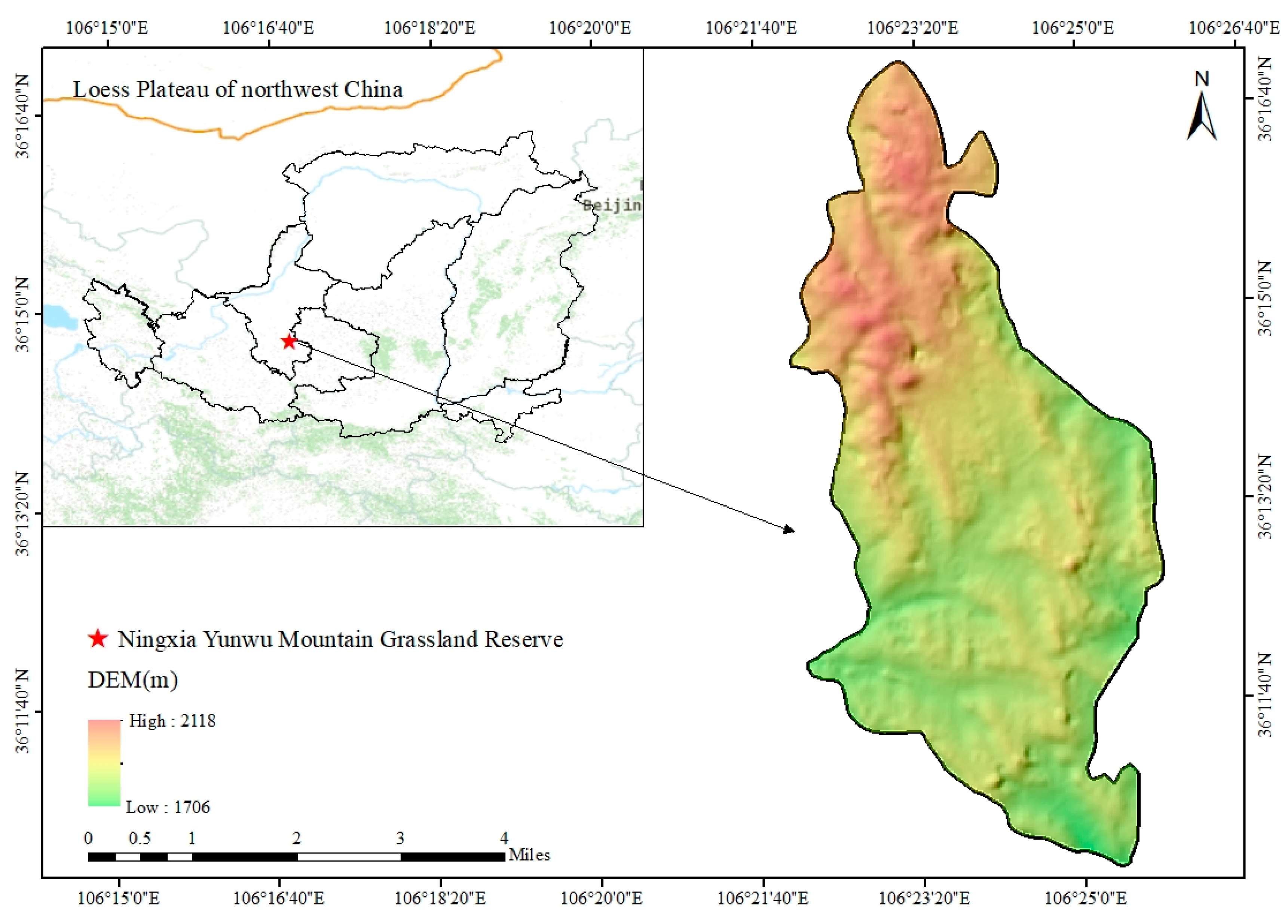
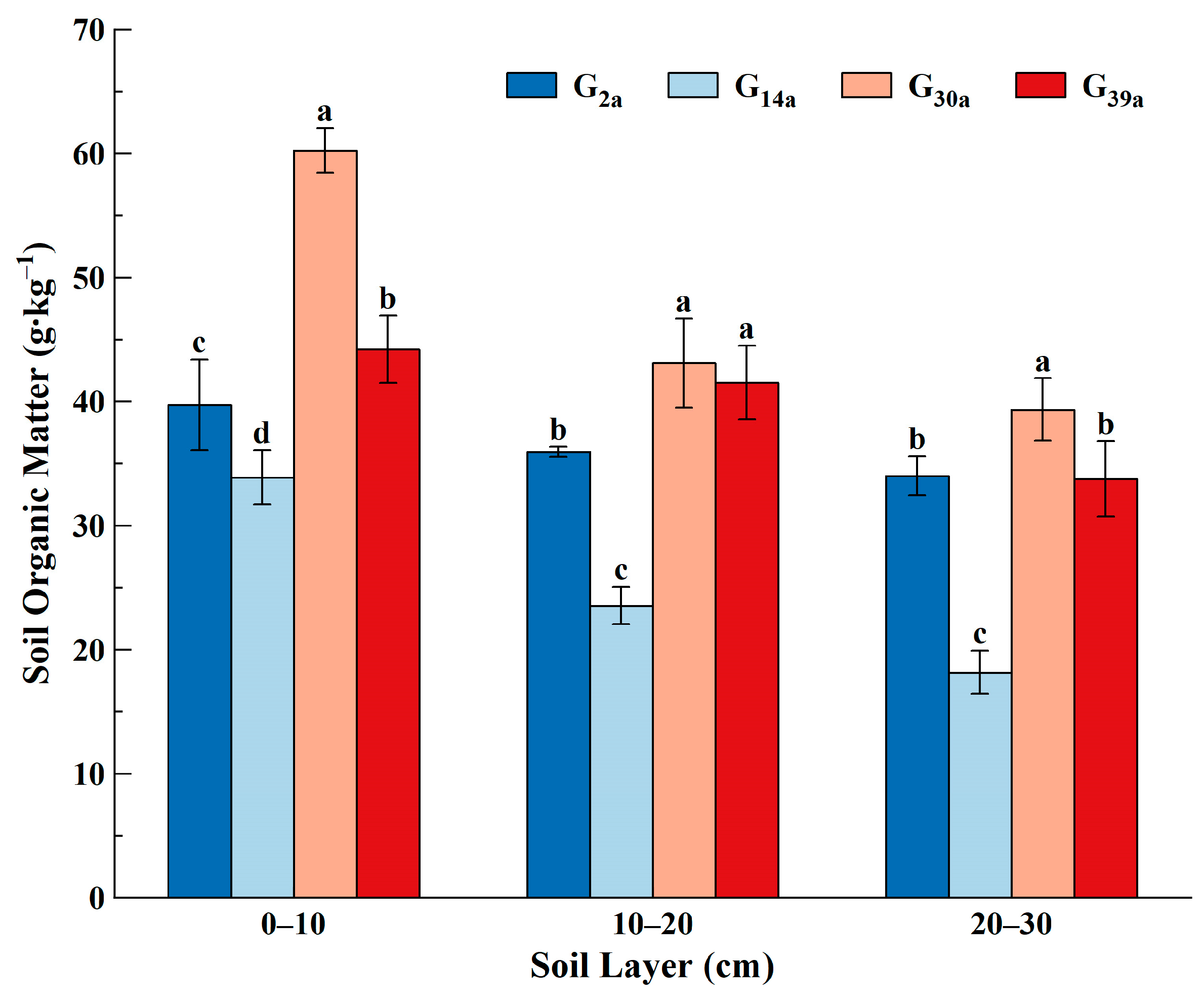
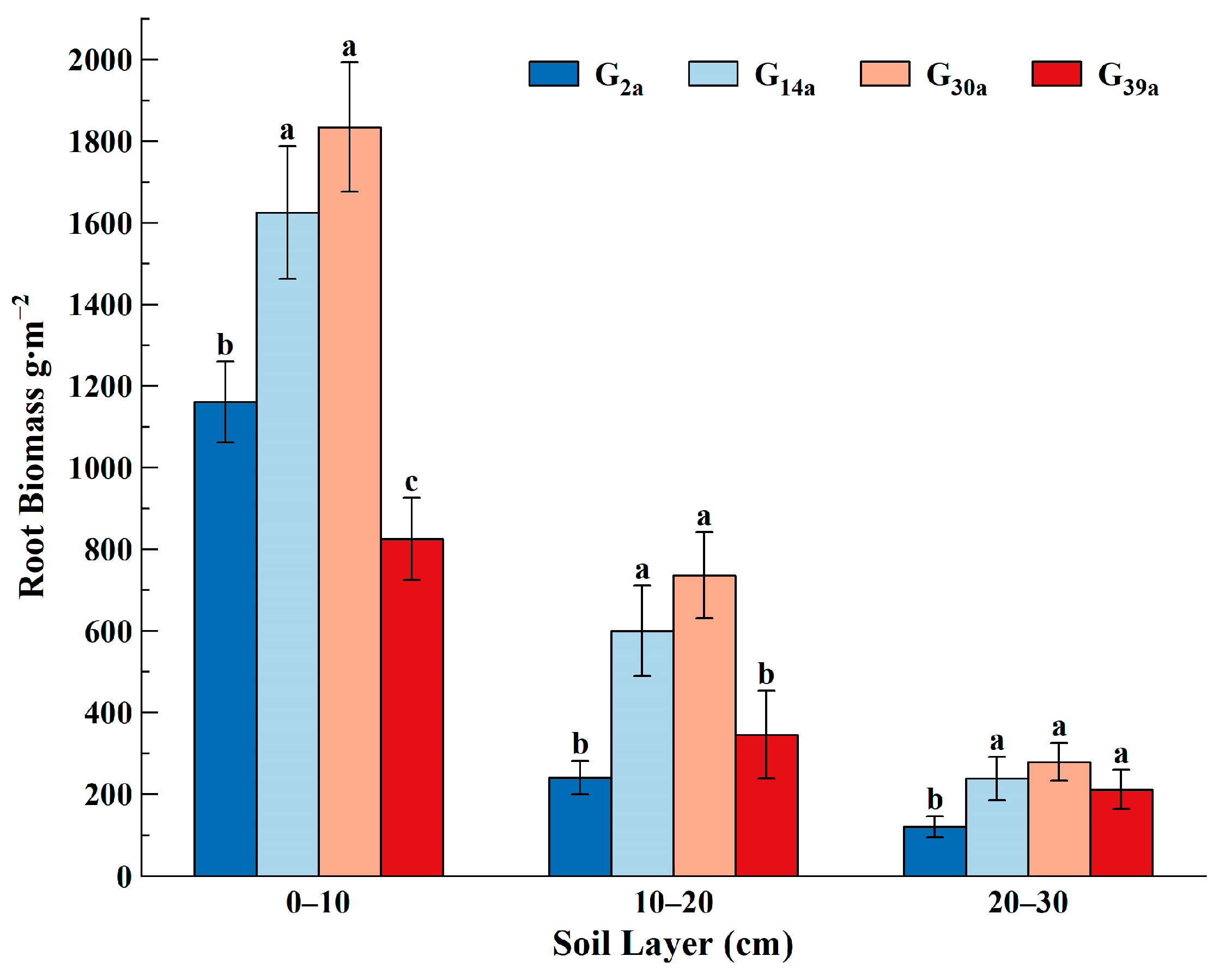
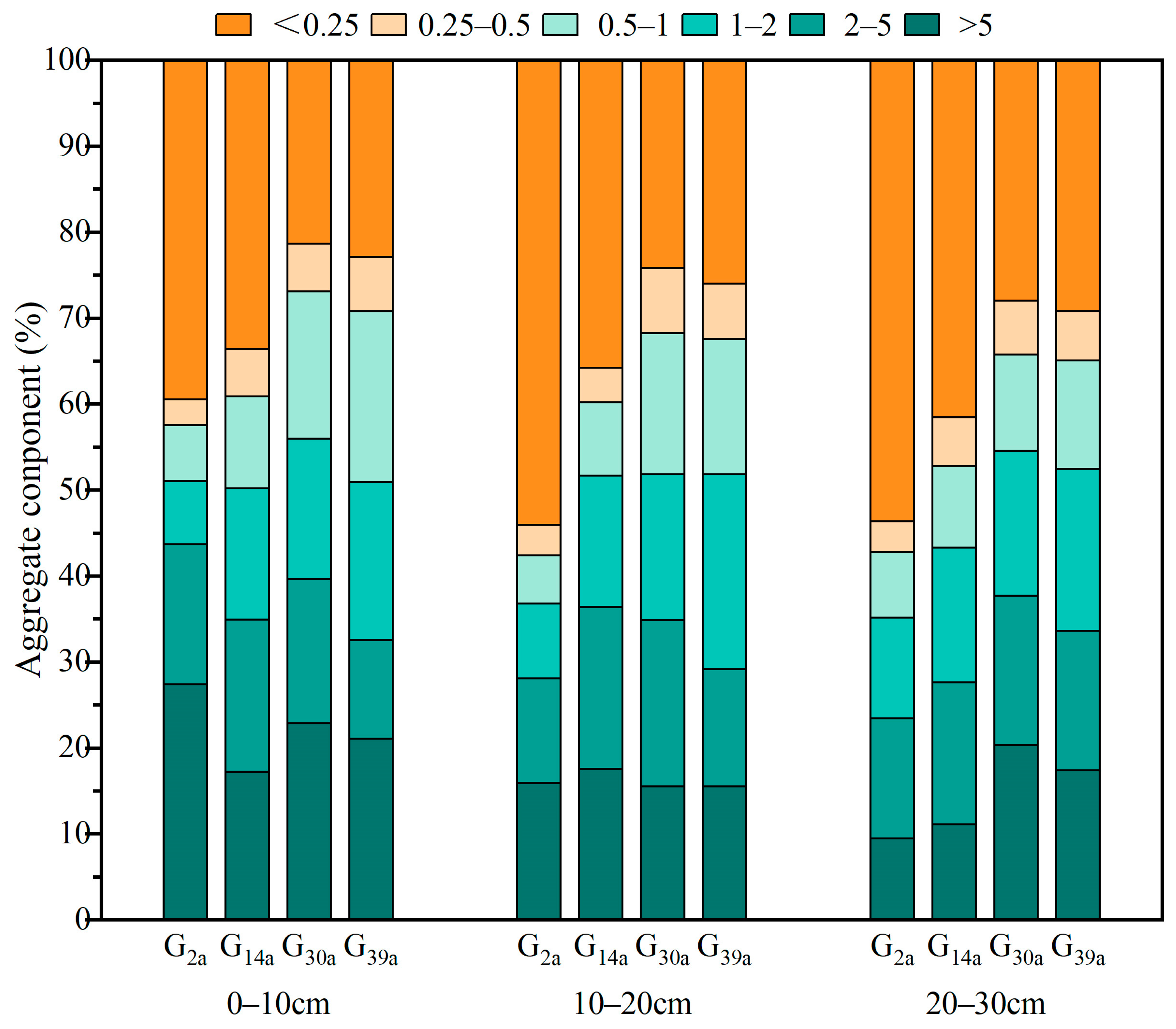
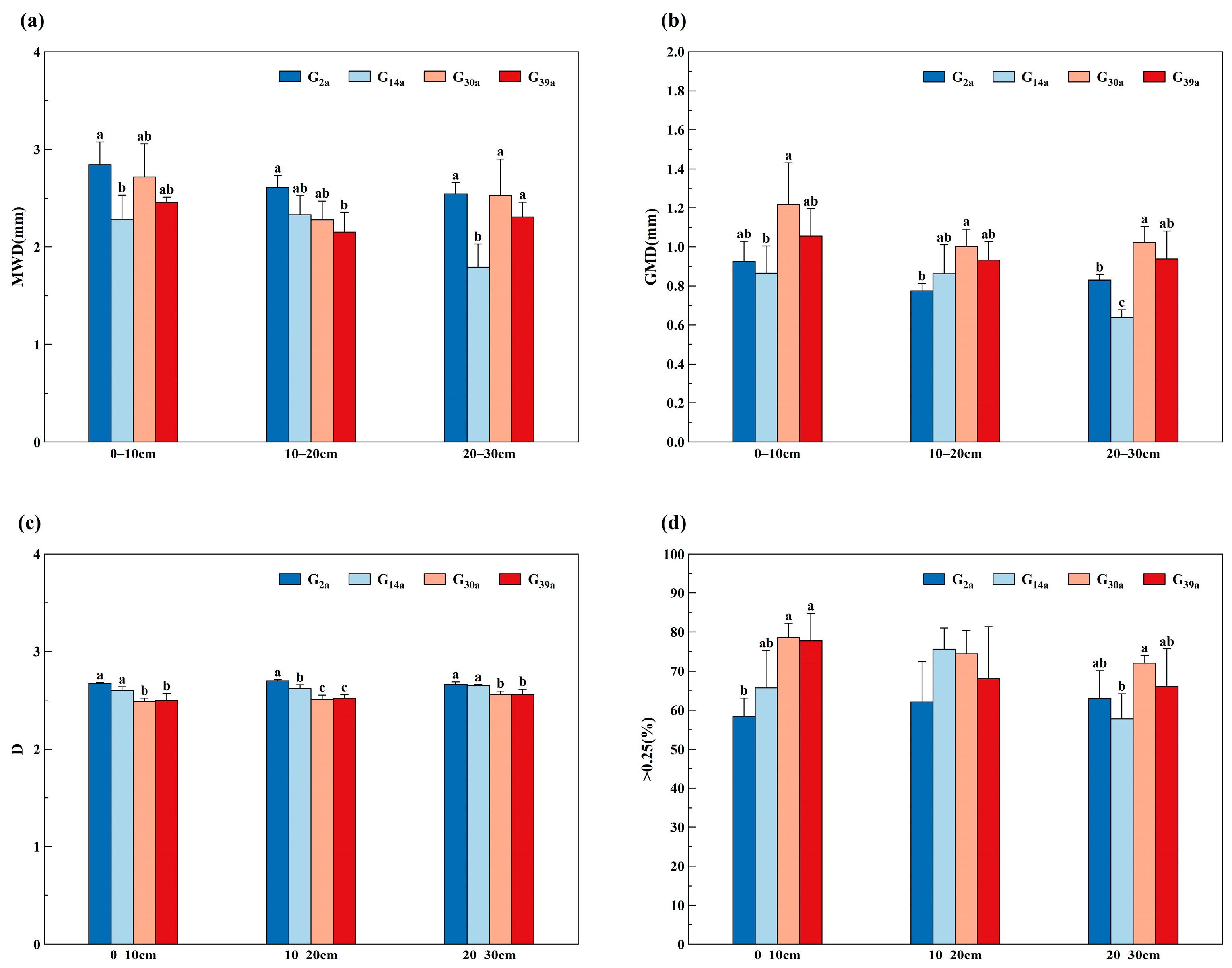
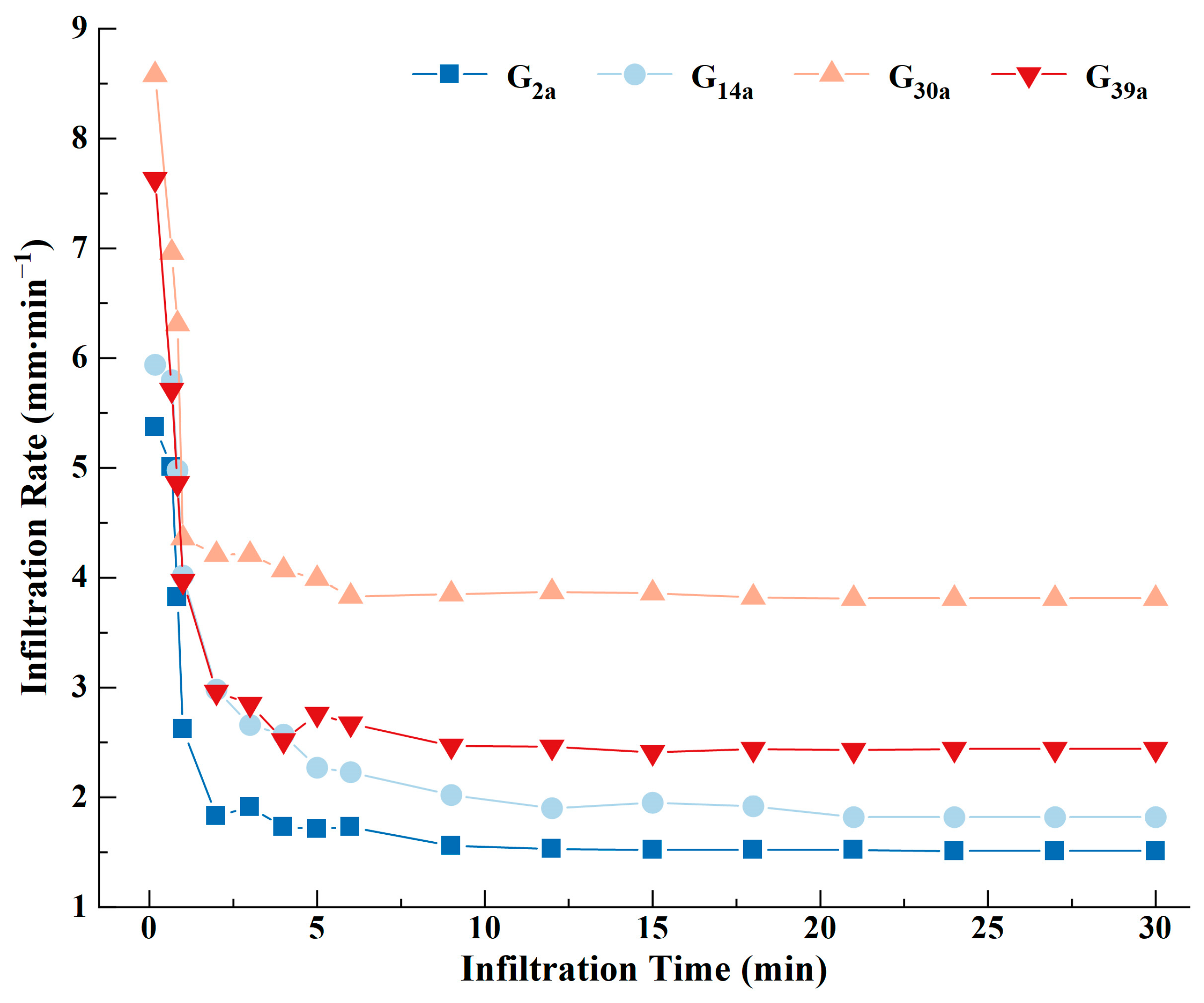
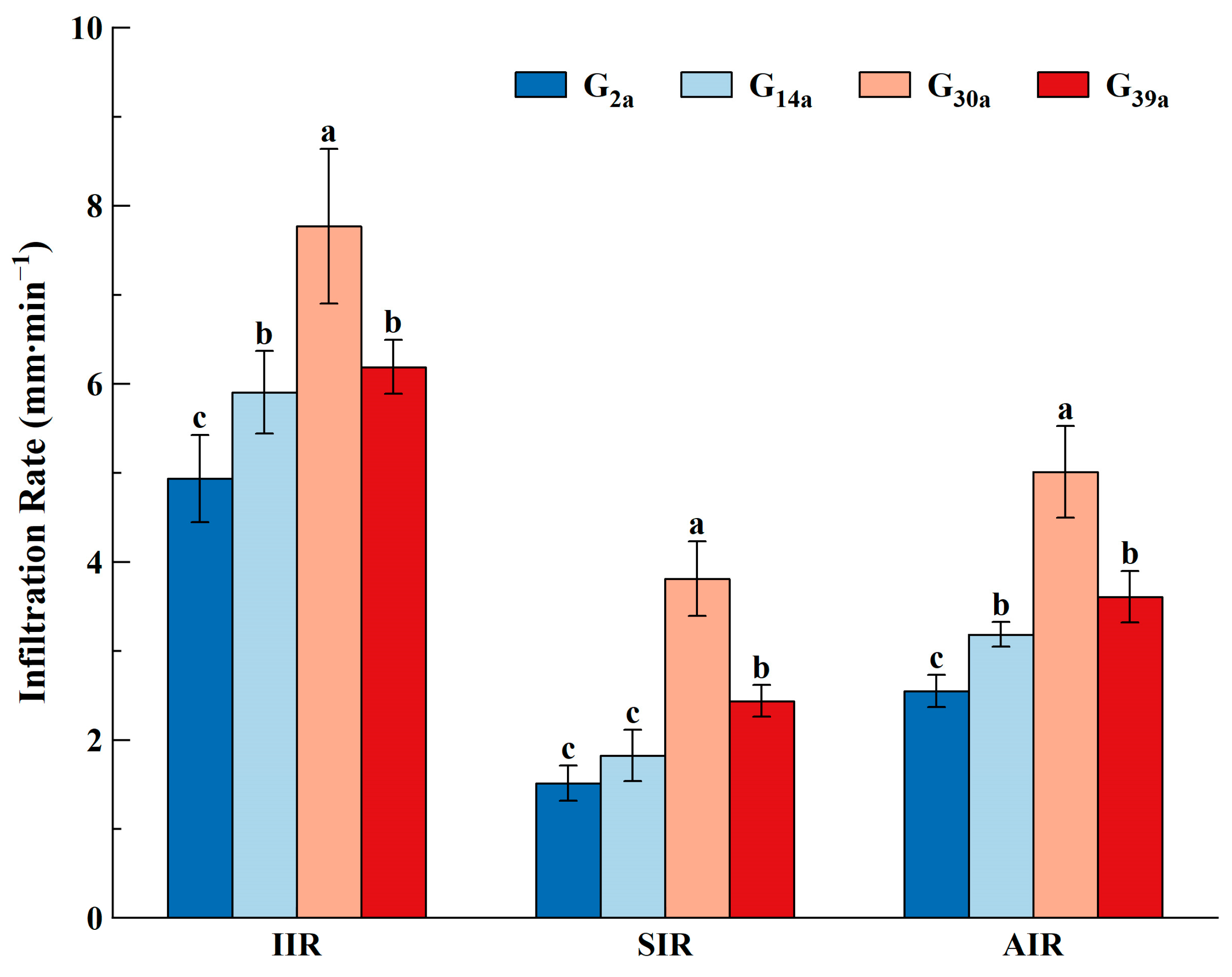
| Sample Plot | Dominant Species | Coverage | Longitude and Latitude |
|---|---|---|---|
| G2a | Stipa przewalskyi Stipa grandis Artemisia stechmanniana | 0.70 | 36°21′ N 106°20′ E |
| G14a | Stipa przewalskyi Stipa grandis Artemisia stechmanniana Thymus mongolicus | 0.75 | 36°22′ N 106°18′ E |
| G30a | Stipa grandis Stipa przewalskyi Artemisia stechmanniana Chrysanthemum lavandulifolium | 0.90 | 36°21′ N 106°20′ E |
| G39a | Stipa grandis Artemisia stechmanniana Stipa przewalskyi | 0.80 | 36°15′ N 106°23′ E |
| Soil Depth (cm) | Plots | BD (g/cm3) | Porosity (%) | Soil Separates | ||
|---|---|---|---|---|---|---|
| Sand | Silt | Clay | ||||
| (>0.02 mm) | (0.02~0.002 mm) | (<0.002 mm) | ||||
| 0–10 | G2a | 1.19 ± 0.03 a | 55.14 ± 1.22 b | 59.57 ± 1.44 a | 26.68 ± 1.23 c | 13.74 ± 0.67 b |
| G14a | 1.18 ± 0.06 a | 55.36 ± 2.21 b | 59.33 ± 2.54 a | 26.92 ± 1.61 bc | 13.75 ± 0.95 b | |
| G30a | 0.89 ± 0.03 b | 66.34 ± 4.65 a | 49.19 ± 3.02 b | 32.17 ± 3.78 a | 18.64 ± 2.55 a | |
| G39a | 0.83 ± 0.04 b | 68.82 ± 1.51 a | 52.22 ± 0.70 b | 30.98 ± 0.68 ab | 16.80 ± 0.53 a | |
| 10–20 | G2a | 1.19 ± 0.02 a | 55.08 ± 0.64 b | 62.56 ± 1.84 a | 25.51 ± 3.02 b | 11.93 ± 2.18 b |
| G14a | 1.21 ± 0.03 a | 54.42 ± 0.99 b | 51.78 ± 3.35 b | 31.51 ± 1.94 a | 16.72 ± 2.05 a | |
| G30a | 0.94 ± 0.05 b | 64.35 ± 2.01 a | 48.70 ± 1.60 b | 33.79 ± 0.98 a | 17.50 ± 0.62 a | |
| G39a | 0.90 ± 0.07 b | 66.21 ± 2.67 a | 51.45 ± 2.45 b | 31.77 ± 0.68 a | 16.78 ± 2.00 a | |
| 20–30 | G2a | 1.21 ± 0.05 a | 54.41 ± 2.05 b | 61.88 ± 2.83 a | 27.03 ± 2.04 b | 11.09 ± 0.80 c |
| G14a | 1.21 ± 0.02 a | 54.34 ± 0.60 b | 49.69 ± 1.01 b | 31.99 ± 0.67 a | 18.32 ± 0.36 ab | |
| G30a | 1.06 ± 0.03 b | 59.82 ± 0.95 a | 47.38 ± 2.80 b | 33.38 ± 2.03 a | 19.25 ± 0.76 a | |
| G39a | 1.01 ± 0.07 b | 63.29 ± 3.42 a | 51.28 ± 0.68 b | 31.71 ± 0.61 a | 17.01 ± 0.98 b | |
| IIR | SIR | AIR | |
|---|---|---|---|
| Bulk Density | −0.597 ** | −0.671 ** | −0.668 ** |
| Porosity | 0.597 ** | 0.671 ** | 0.668 ** |
| SOM | 0.455 ** | 0.584 ** | 0.528 ** |
| >5 mm | 0.436 ** | 0.441 ** | 0.442 ** |
| 2–5 mm | 0.377 * | 0.29 | 0.341 * |
| 1–2 mm | 0.505 ** | 0.446 ** | 0.486 ** |
| 0.5–1 mm | 0.639 ** | 0.638 ** | 0.645 ** |
| 0.25–0.5 mm | 0.638 ** | 0.600 ** | 0.627 ** |
| <0.25 mm | −0.797 ** | −0.748 ** | −0.783 ** |
| GMD | 0.659 ** | 0.626 ** | 0.650 ** |
| D | 0.796 ** | 0.758 ** | 0.786 ** |
| Principal Component | 1 | 2 | 3 | |
|---|---|---|---|---|
| BD | −0.74 | −0.53 | 0.33 | |
| Porosity | 0.74 | 0.53 | −0.33 | |
| SOM | 0.23 | 0.75 | −0.36 | |
| Water-stable | >5 mm | 0.06 | 0.89 | 0.14 |
| Aggregate | 2–5 mm | 0.08 | −0.01 | 0.9 |
| 1–2 mm | 0.91 | −0.08 | 0.03 | |
| 0.5–1 mm | 0.84 | 0.4 | −0.2 | |
| 0.25–0.5 mm | 0.88 | 0.02 | 0.07 | |
| <0.25 mm | −0.86 | −0.44 | −0.23 | |
| GMD | 0.69 | 0.62 | 0.32 | |
| D | −0.9 | −0.39 | −0.14 | |
| Characteristic Value | 6.98 | 1.56 | 1.19 | |
| Contribution Rate | 63.47% | 14.19% | 10.80% | |
| Cumulative Contribution Rate | 63.47% | 77.66% | 88.46% | |
Disclaimer/Publisher’s Note: The statements, opinions and data contained in all publications are solely those of the individual author(s) and contributor(s) and not of MDPI and/or the editor(s). MDPI and/or the editor(s) disclaim responsibility for any injury to people or property resulting from any ideas, methods, instructions or products referred to in the content. |
© 2024 by the authors. Licensee MDPI, Basel, Switzerland. This article is an open access article distributed under the terms and conditions of the Creative Commons Attribution (CC BY) license (https://creativecommons.org/licenses/by/4.0/).
Share and Cite
Qu, Y.; Wu, Q.; Darmorakhtievich, O.H.; Wang, J.; Ren, X.; Chai, X.; Xu, X.; Du, F. Effects of Long-Term Fenced Enclosure on Soil Physicochemical Properties and Infiltration Ability in Grasslands of Yunwu Mountain, China. Land 2024, 13, 1558. https://doi.org/10.3390/land13101558
Qu Y, Wu Q, Darmorakhtievich OH, Wang J, Ren X, Chai X, Xu X, Du F. Effects of Long-Term Fenced Enclosure on Soil Physicochemical Properties and Infiltration Ability in Grasslands of Yunwu Mountain, China. Land. 2024; 13(10):1558. https://doi.org/10.3390/land13101558
Chicago/Turabian StyleQu, Yuanyuan, Qinxuan Wu, Ojimamdov Habib Darmorakhtievich, Junfeng Wang, Xiuzi Ren, Xiaohong Chai, Xuexuan Xu, and Feng Du. 2024. "Effects of Long-Term Fenced Enclosure on Soil Physicochemical Properties and Infiltration Ability in Grasslands of Yunwu Mountain, China" Land 13, no. 10: 1558. https://doi.org/10.3390/land13101558






